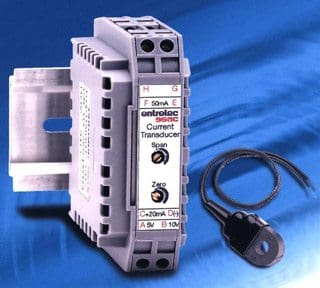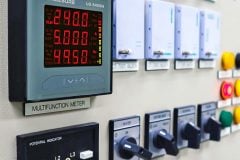
Transducers measure power system parameters by sampling instrument transformer secondaries. They provide a scaled, low-energy signal that represents a power system quantity that the SA interface controller can easily accept. Transducers also isolate and buffer the SA interface controller from the power system and substation environments. Transducer outputs are dc voltages or currents in the range of a few tens of volts or milliamperes.
Transducers measuring power system electrical quantities are designed to be compatible with instrument transformer outputs.
Potential inputs are based around 120 or 115 Vac, and current inputs accept 0 to 5 A. Many transducers can operate at levels above their normal ranges with little degradation in accuracy provided their output limits are not exceeded. Transducer input circuits share the same instrument transformers as the station metering and protection systems; thus, they must conform to the same wiring standards as any switchboard component. Wiring standards for current and potential circuits vary between utilities, but generally 600-V-class wiring is required, and no. 12 AWG or larger wire is used.
Special termination standards also apply in many utilities. Test switches for “in-service” testing of transducers are often provided to make it possible to test transducers without shutting down the monitored equipment. Transducers may also require an external power source to operate. When this is the case, the reliability of this source is crucial in maintaining data flow.
Transducer outputs are voltage or current sources specified to supply a rated voltage or current into a specific load. For example, full output may correspond to 10 V at up to 1.0 mA or 1.0 mA into 10 kΩ, up to 10 V maximum. Some over-range capability is provided in transducers so long as the maximum current or voltage capability is not exceeded. The over-range can vary from 20 to 100%, depending on the transducer.
However, accuracy is usually not specified for the over-range area. Transducer outputs are usually wired with shielded, twisted-pair cable to minimize stray signal pickup.
Practices also differ somewhat on shield grounding, with some shields grounded at both ends, but it is also common practice to ground shields at the SA controller end only. When these signals must cross a switchyard, however, it is a good practice to not only provide the shielded twisted pairs, but it also to provide a heavy-gauge overall cable shield.
This shield should be grounded where it leaves a station control house to enter a switchyard and where it reenters another control house. These grounds are terminated to the station ground mass, and not to the SA analog grounds bus.
Resource: The Interface between Automation and the Substation by James W. Evans, The St. Claire Group











Some great info here Edvard, analog DAQ has come a long way in the last 2-3 years.